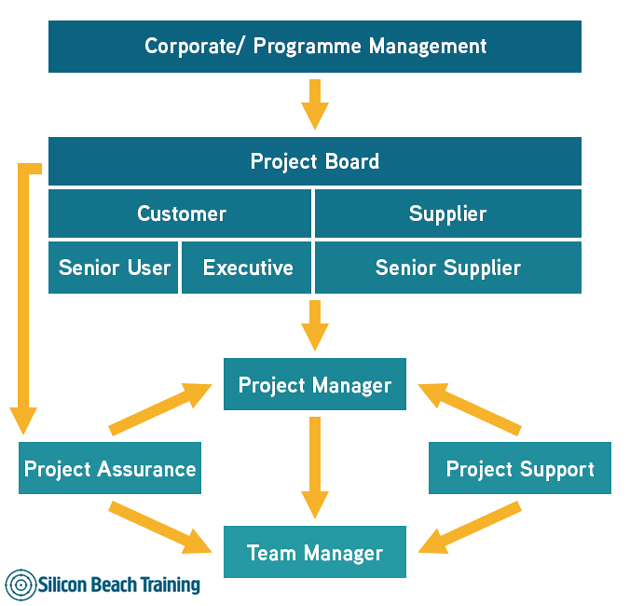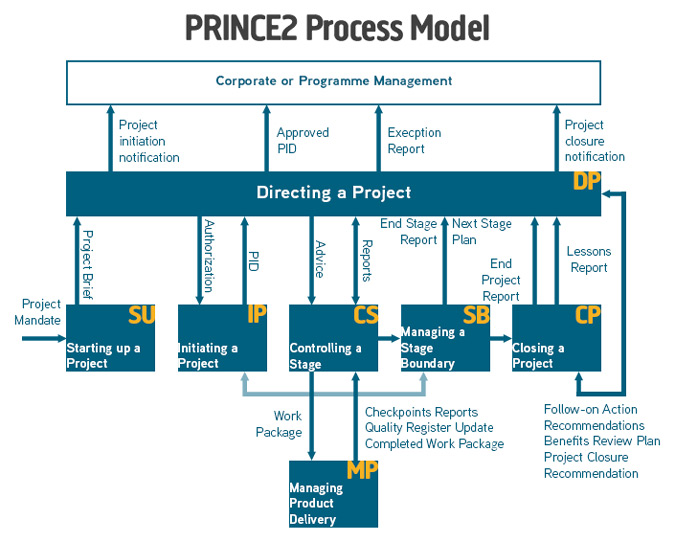As taught on our PRINCE2® Training course, PRINCE2 is a methodology that can be tailored to any project. Therefore it is necessary for there to be a project management structure that can also be tailored to any project.
Using this structure allows us to identify who does what on a project without knowing anything about its size or complexity. The team structure is divided into roles, not jobs and so can be allocated individually or even combined.
Here is our flexible project management team structure:

Here at Silicon Beach Training we pride ourselves on our successful PRINCE2 Foundation training having a 99% pass rate. It must be something to do with the Brighton air, or maybe it's the quality of our training!
Defining the project management team structure
The corporate/ programme management site at the top but pass the decision making down to the Project Board. If you want to sit at this level you need MSP training, which is the next step after completing your PRINCE2 Practitioner training.
The Project Board are also busy on roles outside of the project and so delegate the day-to-day running of the project to the Project Manager. They are there to make the key decisions but if they believe they don't have the time or the right skills then they can appoint somebody to Project Assurance to monitor the project for them.
Andy Trainer
20 Apr 2012
Once you have gained your PRINCE2 Practitioner qualification, or attended Intro to Project Management training and started working on projects, you should be considering the different ways to keep projects running smoothly. One of these is configuration management.
The term configuration management conjures up all sorts of questions for project managers, firstly;
- What is configuration management?
- Do I need it?
- How do I apply it?
What is Configuration Management?
Whether we realise it or not, configuration management exists all around us. For example, the make and model of your car or phone, the version of software you use at home or at work and the documents you use in your daily lives could be version controlled.
Essentially what configuration management covers is how we identify things that need to be version controlled, track these items by keeping records, using naming or labelling the latest versions and control the items by getting approval and ensuring that master copies are kept safe.
Do I Need It?
![]()
You mean there's a better way to organise paperwork?
In a project environment, you will at the very least be generating a large amount of paperwork that as a minimum you will need to manage by configuration management.
Have you ever experienced that situation in a meeting when glancing across at a colleague's collection of paperwork, you notice that they have a later or earlier version of the documentation you have?
If configuration were being managed in your project environment, this situation should not happen.
Ideally, you would at least manage your important documentation by ensuring that approved versions are baselined (approved) and then if changes are required, a new version number is generated. This provides a useful history to review where changes were made or for comparison at the end of the project to compare to the original objectives.
In addition, some projects may also create products or deliverables that would benefit from being managed through configuration. Consider the following questions:
- How will we identify these products?
- Where will we store the products?
- What storage retrieval and security will be in place?
- Who will be responsible for configuration management?
These questions lead me onto the next big question which is:
Claudine
10 Oct 2012
We decided that PRINCE2® diagrams could do with a freshen up so we've created an easy to read, standardised set of diagrams covering the 7 PRINCE2 processes to help learn PRINCE2.
Starting with the PRINCE2 Process Model and then breaking it down into each of the 7 processes.
If you've ever searched Google for 'PRINCE2 diagrams' you will know that it's not a pretty sight, and a lot of those diagrams are either too plain or impossible to decipher.
Our set of diagrams makes the PRINCE2 processes easier to understand by complimenting your PRINCE2 pre-course work and manual when preparing for your PRINCE2 Practitioner Exam.
PRINCE2 Process Model
PRINCE2 describes the steps of project management in seven processes. Any PRINCE2 project will need to address each of the processes but the extent of the application of a process should be decided on a project by project basis.
The PRINCE2 Process Model below describes the relationship between the seven processes:

Andy Trainer
4 Jul 2013
Here's a brief re-cap on the benefits of PRINCE2 for your organisation:
PRINCE2 (PRojects IN Controlled Environments) is a structured method for effective project management. It is a de facto standard used extensively by the UK Government and is widely recognised and used in the private sector, both in the UK and internationally. Here is just a quick list of some of the benefits that using PRINCE2 brings:
- It will mean that there is a common project language and gives flexible decision points.
- It gives a standard approach to managing projects
- It is easier to see the possible problems that might or are occurring.
- It offers reviews of progress against the business case and project care.
- It will also mean that there is a good flow of communications between the stakeholders and other project teams, as well as improved levels of customer satisfaction
- It will also provide a way for being able to manage any deviations from the project plan
Tips for Successful PRINCE2 Management
A PRINCE2 project is not always the easiest job; however here are some quick tips to help you along the way.
Preparation
Being a manager is a position of responsibility, so take it seriously and make sure you properly plan and organise what you want to happen before hand. If you have a clear and organised plan you can give clear and organised instructions and as a result both you and your team will be better off.
A common Understanding
It is essential that both you and your team know what has to be done and are agreed and understand how it is that they are going to do it. Any misleading issues should be carefully explained and any mistakes rectified.
Monitoring
This is a vital part of any management project. You should be taking an active interest in what is happening, who is doing what and, more importantly, if they are doing it correctly or not.
Prioritise
Realise that you cannot do everything at once, or at least do it well, and that it is necessary to prioritise the most important issues and make sure that they are done first.
Competency Within the Team
Make sure that all your team members are up to the task, there is no point letting them continue if they are clearly over their heads, it will not be a good experience for them and it will damage the project. If it is the case that they are capable of doing it but do not understand what is being asked of them then it may be possible to keep them on the project, however if they are clearly struggling then it is their best interests to bring in new people.
Andy Trainer
1 Apr 2009